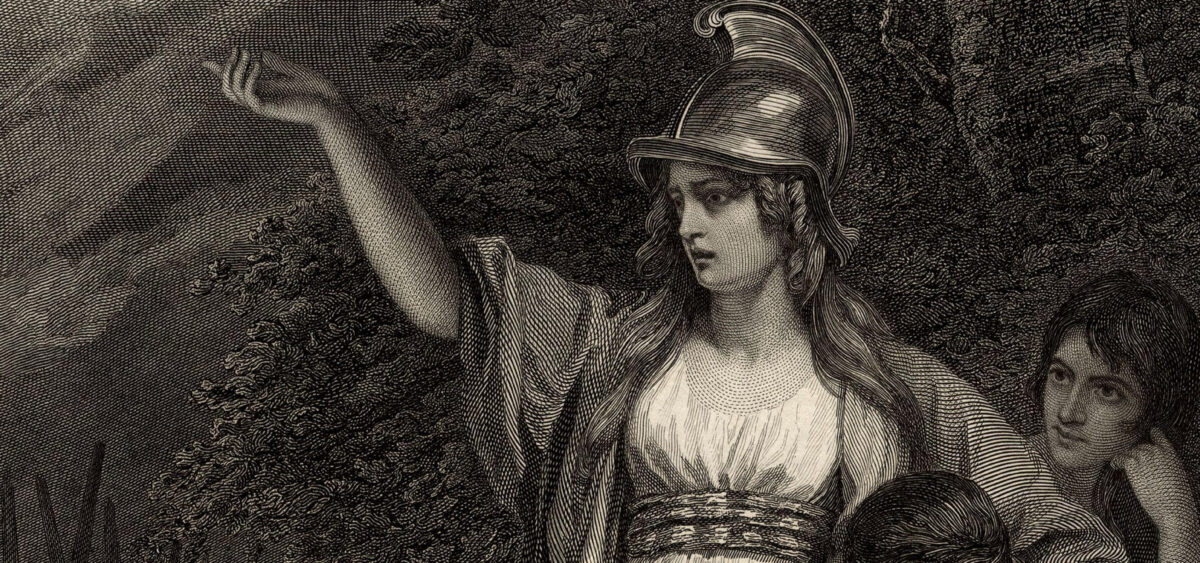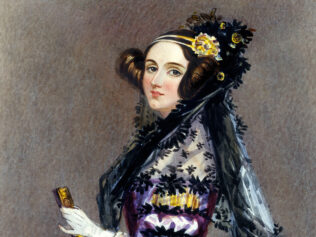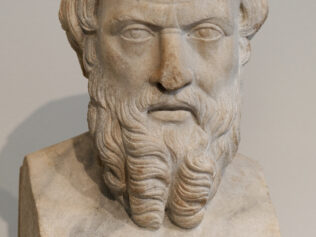
What was it about the queen of the Celtic Iceni tribe that earned her a monument in the very heart of the city she once razed to the ground? Whether Boudica is already triumphant or still on the attack, it’s hard to tell. She holds her left hand high up and brandishes a spear in the right one. The horses that pull her chariot stand on their hind legs, front limbs raised as if getting ready to leap, jump over an obstacle, or fight off an attacker. There are scythe blades attached to each wheel. Boudica’s two daughters are sitting behind her in the chariot. The inscription on the plinth under Thomas Thornycroft’s statue reads as follows: ‘Boadicea [Boudicca]. Queen of the Iceni who died A.D. 61 after defending her people against the Roman invader.’
It doesn’t get more London than this. When standing in front of the Celtic warrior queen, you have the Thames to the right, with a view of the London Eye on the other bank of the river, built to celebrate the turn of the millennium. Behind you is the Palace of Westminster (better known as the Houses of Parliament) and another symbol of Great Britain: Big Ben.
Even though the monument depicts a historical figure from the 1st century CE, both the statue and Boudica herself are more than fit to comment on the modern world. In 2005, Banksy put a wheel clamp on the Iceni queen’s chariot – maybe to draw our memory towards Boudica, or perhaps just as a joke. A decade later, during the Brexit campaign and following Britain’s negotiations with the EU, Boudica’s image was eagerly exploited by journalists and experts alike. Tom Holland of The New York Times thought the statue to be proof of British Euroscepticism; UK newspapers made references to Boudica during Theresa May’s time in Number 10, and in Chris Riddell’s caricature in The Guardian, a nappy-wearing Boris Johnson rode a chariot not unlike that of the rebel queen, with a ‘NO DEAL BREXIT’ inscription in the front. Boudica organized the greatest uprising against the Roman invader in the history of the British Isles. Romans drowned her effort in blood, but, as we can see, the legend of a warrior queen unafraid to challenge an empire lives on.
Caligula’s war on Neptune
In The Twelve Caesars, Suetonius described Caligula’s attempts to conquer Britannia, as the overseas land was known to the Romans. Around the year 39 CE, the son of one of the tribal kings in Britain was exiled from the island. Upon his arrival on the continent with a small troop of soldiers, he surrendered to the Caesar. In turn, Caligula “sent a grandiloquent letter to Rome, as if the entire island had been submitted to him,” wrote Suetonius. Then the eccentric – and perhaps mentally ill – leader declared war on Neptune, the god of the sea. It all took place not far from today’s Bologne-sur-Mer, west of Calais. Caligula sent his armies and artillery to the beach, and ordered his people to attack and cut the waves, after which they were told to collect seashells as the spoils of war.
It was not the first nor the last Roman attempt to colonize Great Britain. The island had always fascinated the Caesars. It held mystery, enforced by the tales of Druids (Celtic priests), and was a potential object of conquest that would allow the empire to keep growing. However, Julius Caesar’s two failed attempts in the years 55–54 BCE put his successors off for decades. Other than the anecdotal achievements of Caligula, it was Claudius who tried again in 43 CE. By the year 60 CE, the Romans were in control of an area reaching as far as today’s Wales in the west and Sheffield in the north.
Prasutagus was the king of the Iceni, a tribe that lived in today’s East Anglia. We don’t know when he was born or when he married. His bride was Boudica (also spelled Boadicea, Boudicea) whose name originated from the Celtic word bouda, meaning ‘victory’. The queen, who probably came from nobility, gave birth to two daughters whose names we do not know. The tribe’s economy was largely agricultural – the Iceni raised cattle and horses, living quite peacefully (or as peacefully as they could under the Roman occupation).
The peace was maintained thanks to Prasutagus’s politics. Perhaps the king surrendered to the Romans at first; maybe he tried to fight back and lost. Eventually, he became one of many puppet rulers in the British Isles. To maintain peace, he had to pay taxes and send young men to serve in the Roman army.
Side note: most of what we know of those times and places we owe to Tacitus and Cassius Dio who, however, were not eyewitnesses of the events they described. Born around 55 CE, Tacitus had the opportunity to hear direct testimonies, while Dio wrote his accounts over 100 years after the deaths of Prasutagus and Boudica. Still, the works of these Roman historians are considered important sources, supported by later archaeological discoveries (some of which are still being made today).
Prasutagus tried to manoeuvre and look for solutions that would satisfy the invaders while guaranteeing the peace of his family. In his will, he divided his wealth and property between his daughters and Nero. According to Iceni law, women could inherit land from men, but Roman law did not allow this. Since Britain had already become a Roman colony, the regulations imposed by the Empire superseded the local rules.
Once Prasutagus died, Rome demanded the rest of his land. Legionaries broke into the king’s residence, undressed and flogged Boudica (to demonstrate that after her husband’s death, she was no better than a slave) and raped her daughters. All men from the king’s family became slaves, and the properties of other wealthy Iceni were plundered. This Roman brutality led to an unexpected outcome. As Caitlin C. Gillespie writes in her book Boudica: Warrior Woman of Roman Britain: “In AD 60/61, Rome almost lost the province of Britain to a woman.”
A hare of hope
“I know it’s unusual for Britons to fight under a woman’s leadership, but forget that I am a woman or a member of a royal family. Now I am one of you, regaining my freedom, avenging my scourged body and the lost chastity of my daughters. The gods are on the side of righteous vengeance. In this battle, you must conquer or die! This is a woman’s resolve. As for you men, you can choose to live, and be slaves, if you wish,” Boudica was said to have called to her troops before the fight that British historians call the Battle of Watling Street. After the speech, Boudica let a hare escape from the folds of her gown, and the animal leaped off in what historians described as an “auspicious direction”. The rebel army was overjoyed. It was a sign that the heavens were on their side.
First, however, the defiled Boudica had to mobilize the Iceni. Perhaps it was her charisma, or maybe the queen managed to convince her tribesmen with a rational and well-planned strategy. In the spring of 60 CE, two out of four legions stationed in Britain were expecting conscription and a change of leadership. Boudica decided to wait for rookies to replace the veterans, and she painted her vision of defeating the invaders so realistically that she managed to convince not only the Iceni but also other Celtic tribes to join the uprising. By autumn, the rebel forces were getting ready to strike. Among other preparations, they built the chariots that had been a fundamental part of their armoury since the times of Julius Caesar. The vehicles looked a little different from the one immortalized in the aforementioned statue in Westminster. Nobody attached scythe blades to the wheels and Boudica didn’t drive the vehicle herself – she had a charioteer.
The rebellion began with an attack on the capital of Roman Britain, Camulodunum (today’s Colchester). Destruction of the city that was the symbol of Roman power in Britain encouraged more tribes to join Boudica. Perhaps it made them believe that defeating the Romans was a real possibility. Then the rebel forces attacked Londinium (London) and Verulamium (St Albans), leaving nothing but ash and blood in their wake.
Boudica’s uprising was exceptionally brutal, even for her contemporaries. Fuelled with anger and vengeance, her forces spared no one, murdering even children, women and the elderly. They asked no questions – who was with or against them, who was collaborating with the enemy and who supported the rebellion. Boudica’s troops simply slaughtered one settlement after another. The worst fate awaited women who had married the legionaries that settled in Britain once they were released from army service. The Celts hanged the women, cut off their breasts and then sewed them to their mouths. They also cut off men’s genitals and buried maimed victims alive, impaled them, or hanged them on crosses. Along with torture, they held feasts in the name of Andraste, the Celtic goddess of victory. It seems the rebels were blinded by their hatred.
Tacitus wrote that instead of murdering the captives, they could have sold them into slavery or demanded ransom. Contemporary researchers, however, suggest that the cruelty against the rich women had a purpose other than torment. Vanessa Collingridge wonders whether the sewing of breasts to the mouths of the traitorous women was a message to “shut them up” and “eat their words, having ordered a similar sexual humiliation of [Boudica] and her daughters.” Caitlin C. Gillespie insists that “by destroying [female] bodies, Boudica symbolically destroys the potential for the growth and prosperity of the Romans in Britain,” adding that “the noblewomen are selected as a worthy tribute to a female goddess.” Despite the initial success, from today’s perspective, it is clear that Boudica’s uprising was doomed to fail. After all, the queen stood up to the greatest military power of her era. Rome’s recovery and regaining of control over the situation was only a matter of time.
Historians and archaeologists still dispute where exactly the decisive Battle of Watling Street took place. The road was several hundred miles long; the most likely location is the area northwest of today’s London, perhaps near St Albans. During the battle, 230,000 soldiers fought under Boudica, and only 10,000 under the Roman governor of Britain, Gaius Suetonius Paulinus. But it was not numbers that decided the victory.
On the day of the battle, it turned out that Boudica was leading a disorganized crowd, while the experienced Suetonius Paulinus (who rose to fame after suppressing a revolt in Mauretania) had a disciplined, well-equipped and trained army instead. The Celts had plenty of willpower and fighting spirit at their disposal, but the Romans used tactics and advanced equipment against them.
“With a cheer, the three tightly knit wedges strode forward and met the mass of oncoming warriors on the move. The wedge was just one of a number of formations that legionaries were trained to use. But on the receiving end, the Britons had never come across anything like it, and they didn’t know how to counter it. With shields pumping in and out and swords slashing and jabbing over the top, the Roman wedges were like giant threshing machines, breaking up opposition lines and chewing up divided groups of men,” writes Stephen Dando-Collins.
In the end, the Iceni queen lost 80,00 people, whereas Suetonius Paulinus lost only 400. The Briton’s greatest revolt was brutally quenched. Boudica swallowed poison, and her people were said to have given her a royal funeral and grieved for a long time.
Boudica in court
The memory of the legendary leader was revived during the rule of Queen Victoria. Partly because the names of both queens mean ‘victory’, and partly because some began to consider Victoria – who ruled the empire on which the sun never set – as Boudica’s heiress. In 1864, Alfred, Lord Tennyson published his poem “Boadicea”, and the Westminster Bridge monument was erected soon after.
Boudica will not be forgotten any time soon. Today, the Iceni queen is commemorated in various parts of the United Kingdom. Her statue stands in Cardiff City Hall. Last year, the Isle of Man released a £5 coin in the shape of the Celtic cross; the obverse of the coin depicts the profile of Queen Elizabeth II, and the reverse presents an effigy of the Celtic monarch with an inscription that reads ‘Boudica. Warrior queen’. Boudica has also became a pop culture character, featured in films, television series and video games.
In autumn 2021, Classics for All – a charity that encourages the teaching of the languages, history and culture of the Classical World in state schools – organized a moot trial of Boudica at the UK Supreme Court. Boudica was accused of terrorism and plundering three cities. The counsel for the prosecution was Alison Morgan QC, previously involved in prosecuting the organizers of the 2005 London bombings. The jury decided that Boudica’s actions were a justified act of self-defence against “a rotten and illegitimate Roman government.”
Sources: Boudica: Warrior Woman of Roman Britain by Caitlin C. Gillespie, Boudica: The Life of Britain’s Legendary Warrior Queen by Vanessa Collingridge, and Nero’s Killing Machine: The True Story of Rome’s Remarkable Fourteenth Legion by Stephen Dando-Collins.

Translated from the Polish by Aga Zano










